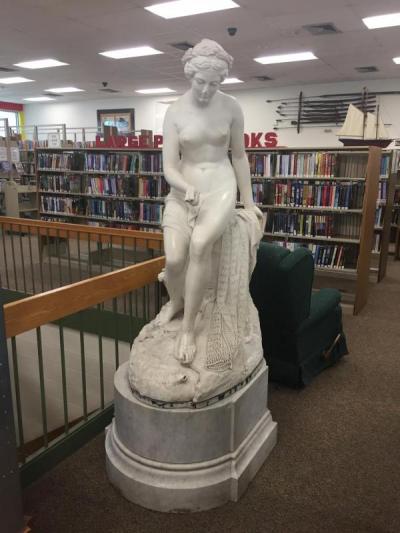What's the deal with the library's 'Fishermaid' statue?
The two-ton woman sitting adjacent the stairs at Southworth Library is as much a mystery as she is a beauty, which may be why someone is interested in buying her.
The Fishermaid — made of carved, Italian white marble — was moved into the library on September 23, 1982. Little else is known of the statue's history, except what is offered via a few printouts kept in Libraries Director Lynne Antunes' office.
At a Board of Library Trustees meeting last week, Antunes said that someone had expressed interest in buying the statue. The announcement sparked a discussion on the piece's background.
According to the small collection of Wikipedia pages, handwritten notes, and scanned magazine spreads, the Fishermaid was sculpted by Scipione Tadolini (1822-1892) sometime around 1853. According to Glasgow City of Sculpture, Tadolini — the eldest son of the famous sculptor Adamo Tadolini — jumpstarted his career at 24 years of age with Nymph Fishing (1846).
"Scipione acquired the studio on his father's death in 1868, and soon established a successful career as a sculptor of figures and groups in marble," the article reads. "His work was much sought after, especially amongst wealthy foreign visitors to his studio."
Tadolini made three copies of the Fishermaid. One version of the statue went to a Russian man, while another went to England. The third was purchased by the wealthy Colonel Edward "Ned" Howland Robinson Green.
The Fishermaid resided in the front lobby of Green's mansion at Round Hill through his death. When his sister, Henrietta Green Wilks, took over the estate, she donated the statue to the Poole School (which is currently Town Hall).
"The art room was my homeroom when I was in high school, and [the statue] was in that room in the '60s," said Antunes, recalling her stint at the Poole School.
The statue was later given to the library by the school department. The transport was funded by the Friends of the Libraries, and completed by Rex Monument Company, according to library staff research.
According to an unsigned, typed document (dated October 2016), the Fishermaid does not represent a particular historical or mythological personage, nor is the model's identity known.
"The figure originally held a net in her hand. The net was already broken off when the statue arrived. We do not know if the Fishermaid was damaged at Round Hill, or in transit from Italy," the document says.
Antunes said that she is interested in getting the statue appraised, but that selling town property can be a complicated procedure. With the board's permission, she is looking into whether the library can sell it or not.















